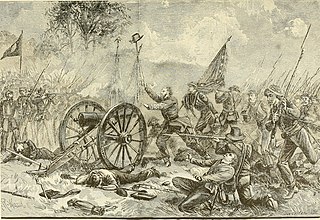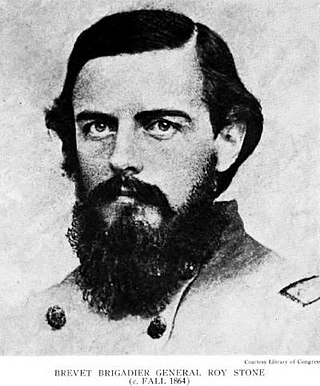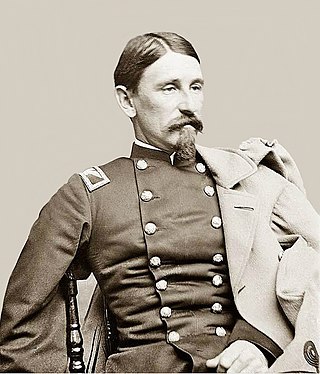
The Battle of Gettysburg was a three-day battle in the American Civil War fought between Union and Confederate forces between July 1 and July 3, 1863, in and around Gettysburg, Pennsylvania. The battle, which was won by the Union, is widely considered the Civil War's turning point, ending the Confederacy's aspirations to establish an independent nation. It was the Civil War's bloodiest battle, claiming over 50,000 combined casualties over three days.

John Fulton Reynolds was a career United States Army officer and a general in the American Civil War. One of the Union Army's most respected senior commanders, he played a key role in committing the Army of the Potomac to the Battle of Gettysburg and was killed at the start of the battle.

Pickett's Charge was an infantry assault on 3 July 1863, during the Battle of Gettysburg. It was ordered by Confederate General Robert E. Lee as part of his plan to break through Union lines and achieve a decisive victory in the North. The charge was named after Major General George Pickett, one of the division commanders under the Confederate Army's command. The assault was aimed at the center of the Union Army's position on Cemetery Ridge, which was believed to be a vulnerable point in the Union defenses. As the Confederate troops marched across nearly a mile of open ground, they came under heavy artillery and rifle fire from entrenched Union forces. The open terrain offered little cover, making the Confederate soldiers easy targets, and their ranks were quickly decimated. Although a small number of the Confederate soldiers managed to reach the Union lines and engage in hand-to-hand combat, they were ultimately overwhelmed. The charge ended in a disastrous defeat for the Confederates, with more than half of the men involved either killed, wounded, or captured. Pickett's Charge marked the climax of the Battle of Gettysburg. The failure of the charge crushed the Confederate Army's hopes of winning a decisive victory in the North and forced General Lee to retreat back to Virginia.

Alfred Moore Scales was a North Carolina state legislator, Confederate general in the American Civil War, and the 45th Governor of North Carolina from 1885 to 1889.

James Johnston Pettigrew was an American author, lawyer, and soldier. He served in the army of the Confederate States of America, fighting in the 1862 Peninsula Campaign and played a prominent role in the Battle of Gettysburg. Despite starting the Gettysburg Campaign commanding a brigade, Pettigrew took over command of his division after the division's original commander, Henry Heth, was wounded. In this role, Pettigrew was one of three division commanders in the disastrous assault known as Pickett's Charge on the final day of Gettysburg. He was wounded, in the right hand, during the Pickett-Pettigrew Charge on July 3, 1863, and was later mortally wounded during the Union Confederate rearguard action while the Confederates retreated to Virginia near Falling Waters, Virginia, on July 14, dying several days thereafter on July 17, 1863.

Evander McIver Law was an author, teacher, and a Confederate general in the American Civil War.

Cemetery Ridge is a geographic feature in Gettysburg National Military Park, south of the town of Gettysburg, Pennsylvania, that figured prominently in the Battle of Gettysburg, July 1 to July 3, 1863. It formed a primary defensive position for the Union Army during the battle, roughly the center of what is popularly known as the "fish-hook" line. The Confederate States Army launched attacks on the Union positions on the second and third days of the battle, but were driven back both times.

George Jerrison Stannard was a Vermont farmer, teacher, government official and Union general in the American Civil War.

The first day of the Battle of Gettysburg during the American Civil War took place on July 1, 1863, and began as an engagement between isolated units of the Army of Northern Virginia under Confederate General Robert E. Lee and the Army of the Potomac under Union Maj. Gen. George G. Meade. It soon escalated into a major battle which culminated in the outnumbered and defeated Union forces retreating to the high ground south of Gettysburg, Pennsylvania.
The Philadelphia Brigade was a Union Army brigade that served in the American Civil War. It was raised primarily in the city of Philadelphia, Pennsylvania, with the exception of the 106th regiment which contained men from Lycoming and Bradford counties.

Roy Stone was an American soldier, civil engineer, and inventor. He served in the American Civil War, distinguishing himself during the Battle of Gettysburg, and took part in the Spanish–American War. He pursued a civil engineering career in a peacetime and became in 1893 the first head of the Office of Road Inquiry, which was the Federal Highway Administration's predecessor.

The 26th North Carolina Infantry Regiment was an infantry regiment of the Confederate States Army during the American Civil War. The regiment was composed of ten companies that came from various counties across North Carolina and Virginia. It is famous for being the regiment with the largest number of casualties on either side during the war.

Thomas Algeo Rowley was a Union Army general in the American Civil War. Following charges about the conduct of his officers at Gettysburg, Rowley was tried by a court martial that was later declared biased, and he was reinstated.

George Fisher McFarland was an American educator from Juniata County, Pennsylvania and an officer in the Union Army during the Civil War. He was the lieutenant colonel of the 151st Pennsylvania Infantry and commanded the regiment in severe combat during first day of the Battle of Gettysburg.

The Iron Brigade, also known as The Black Hats, Black Hat Brigade, Iron Brigade of the West, and originally King's Wisconsin Brigade was an infantry brigade in the Union Army of the Potomac during the American Civil War. Although it fought entirely in the Eastern Theater, it was composed of regiments from three Western states that are now within the region of the Midwest. Noted for its excellent discipline, ferocity in battle, and extraordinarily strong morale, the Iron Brigade suffered 1,131 men killed out of 7,257 total enlistments: the highest percentage of loss suffered by any brigade in the United States Army during the war.

James Keith Marshall was a Confederate Army officer during the American Civil War. Marshall commanded the wounded J. Johnston Pettigrew's brigade during Pickett's Charge at the Battle of Gettysburg and died during the assault.

William Root Brewster was an officer in the Union Army during the American Civil War who commanded a regiment in the famed Excelsior Brigade of the Army of the Potomac. He later commanded the brigade, including at the Battle of Gettysburg where Brewster and his men were overrun by Confederates while defending the Emmitsburg Road position of the III Corps not far from the Peach Orchard.

George Lamb Willard was an officer in the United States Army who served in the Mexican-American War and the American Civil War. He lost his life leading a brigade in the II Corps at the Battle of Gettysburg. Colonel Willard was the namesake of Fort Willard.
Henry J. Stainrook, occasionally spelled Steinrock, led a regiment of the Army of Virginia and the Army of the Potomac in the American Civil War. He briefly led a brigade at the Battle of Antietam. Stainrook was killed in the Battle of Chancellorsville.

The 151st Pennsylvania Infantry was a Union Army regiment serving for a term of nine months during the American Civil War. The regiment sustained seventy-six percent casualties in the Battle of Gettysburg, its only major engagement.

















